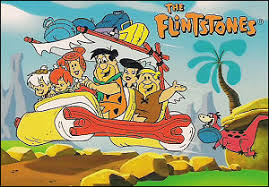William Hanna and the Hanna Barbera Story
Listen to the Recess! Clip
| Author | Kevin Shortsleeve |
| Air Date | 7/29/2002 |

William Hanna and the Hanna Barbera Story Transcript
Today we celebrate the birthday of William Hanna who, along with his partner, Joseph Barbera, formed the award winning partnership, Hanna Barbera which brought us some of the most popular cartoons ever produced for American television. From The Flintstones, to The Jetsons to Mutley and Dastardley, to Hucklberry Hound and Yogi Bear. From Wally Gator, Quick Draw McGraw to Snaggelpus and on to Tom and Jerry – it is difficult to imagine American pop culture without the influence of Hanna Barbera-and they have some famous sound effects as well. Here’s Fred Flintstone getting hit by his rock-hard newspaper.
Brief sound clip
William Hanna was born July 14, 1910 in Melrose New Mexico. He studied engineering and journalism in college. In 1930, he switched careers and started cartooning and in 1937 he joined MGM as a director and story man in the animation department. Joseph Barbera was born in 1911 in New York City. He was working as a banker for a trust company in New York when he decided to start submitting cartoons to magazines. After he sold his first cartoon to Collier’s Magazine, he left his day job…
… and endeavored to become a full-time cartoonist. Relocating to California, he joined MGM as a sketch artist the same year that Hanna had been hired. When the two men met, it was a strike of good fortune for both of them.
At MGM, Hanna and Barbera created Tom and Jerry-the quintessential cat and mouse team-and produced more than 200 films in the series between 1940 and 1957 and in that period they won no less that seven Oscars for their efforts.
In 1957 they left MGM and formed their own production company. They developed a system whereby their animators could use a computerized catalog of character movements. And by doubling frames, they reduced by half, the number of different images required to fill up one second of animation. Where Disney films, for example, used 24 images a second, an episode of the Flintstones would only use only twelve. Fluid motion was sacrificed-but the technique did take a bite out of production time.
The rest, they say, is television history-but perhaps Fred Flintstone puts it best when he says…
Brief sound clip